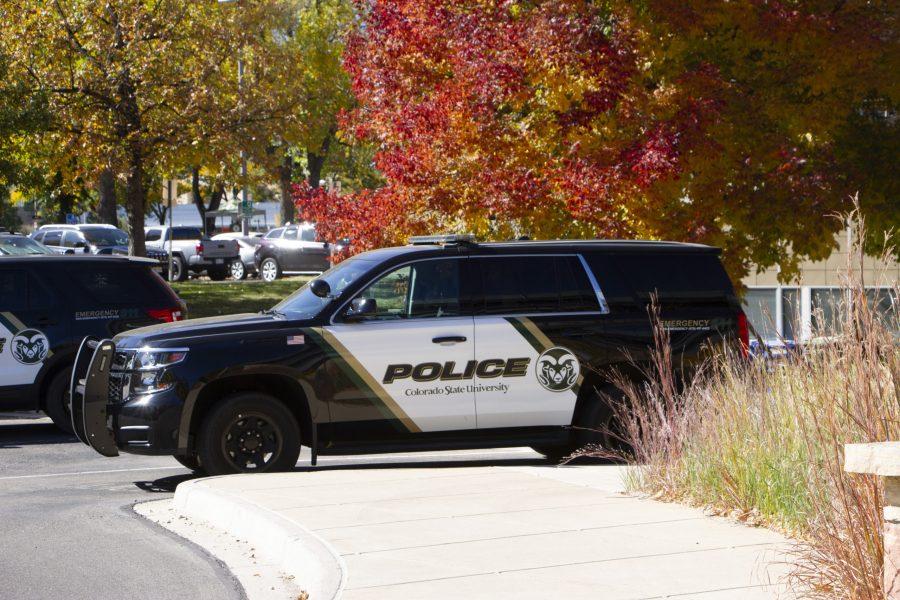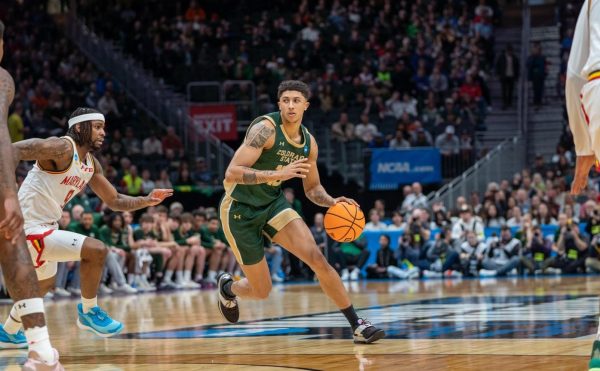Rams take care of Rams: Emergency safety plans
Collegian | File Photo
Parked CSU Police vehicle on the back side of Green Hall, now known as the Colorado State University Police Department Oct. 13, 2020.
April 18, 2023
Trigger warning: This article discusses the topic of gun violence.
This year 74 people were killed or injured by guns in American schools by the beginning of April, according to NPR. Less than a month ago on March 22, there was a shooting at East High School in Denver.
With the prevalence of gun violence on school campuses in the United States, it is no surprise some Colorado State University students feel concerned over the possibility of an active shooter situation occurring on CSU’s campus.
“It’s definitely a thought that crosses my mind,” said Bryce Greenwood, a first-year student. “I definitely feel safe up here (at CSU), but it’s one of those things where it’s the ‘what if’ factor (that makes you think).”
Greenwood said she does not know what she would do in the event of an active shooter on campus. She is not alone.
“I’ll be honest — I don’t actually know much of anything to do procedure-wise … if there was a shooting,” said Tristan Regan, a junior at CSU. “I just go back to what I learned in middle school and high school.”
This sentiment is echoed by other CSU students and is something CSU Police Department police chief Jay Callaghan said he hopes students will take a moment to consider.
“(CSU police officers) are not everywhere at once; we can’t be everywhere. It goes back to — and I’m sure you have heard this before — that ‘see something, say something.’ (If) you see something that is suspicious, (contact someone), even if you think, ‘The dispatcher is probably gonna laugh at me, (and) the police officer is probably not going to come.’ We will come.” -Jay Callaghan, CSU Police Department chief of police
“It’s one of those conversations that you have to address the elephant in the room, and as the saying goes, ‘You want to be prepared before you are tested,’” Callaghan said. “Hate is hate, and it’s something that we as a society are forced to deal with, and I’d rather be prepared when that (time) comes to minimize the impact it has on innocent people.”
Callaghan said as unpleasant as it is to consider, it is important to have a plan and to develop situational awareness when on campus. Knowing where exits are, where hiding places are and who is around you can make a big difference in the event of an active shooter on campus.
Callaghan described how he responded to an incident where a suspect with a gun fled into a Walmart. The suspect was restrained quickly, and no one inside the Walmart was harmed. In clearing the building, Callaghan found a woman hiding in the middle of a circular clothes rack less than 50 feet from an emergency fire exit. When Callaghan asked the woman why she chose not to leave the building through the fire exit, the woman simply responded, “There wasn’t a fire.”
Thinking about how to get out of a situation ahead of time is important because decision making can become much more difficult in high-stress situations, Callaghan said.
Callaghan said the CSU Police Department does active assailant training to hone their tactics several times a year, as do other law enforcement agencies in Northern Colorado.
In the event of an active assailant on campus, the response from law enforcement would be immediate and overwhelming. It would draw law enforcement officers to campus from all over Northern Colorado and even from southern Wyoming to neutralize the threat as quickly as possible, Callaghan said.
Despite that wide response, Callaghan said the first line of defense is the students themselves.
“(CSU police officers) are not everywhere at once; we can’t be everywhere,” Callaghan said. “It goes back to — and I’m sure you have heard this before — that ‘see something, say something.’ (If) you see something that is suspicious, (contact someone), even if you think, ‘The dispatcher is probably gonna laugh at me, (and) the police officer is probably not going to come.’ We will come.”
Callaghan said students and faculty would be alerted to the incident through numerous channels but most notably through push notifications to their phones and emails.
The run, hide, fight training many students received in high school is still the best practice in the event of an active assailant on campus.
“I have taught active assailant training for years, and we teach it here at CSUPD as well,” Callaghan said. “If you can get out of that (active assailant) situation, get out, first and foremost.”
Callaghan also discussed the impact school shootings can have on people’s mental health, even if they were not there to experience the event. He discussed the connections students at CSU have to East High School and encouraged any students impacted by the shooting or any other traumatic incidents to seek out mental health services on campus.
Reach Grant Coursey at news@collegian.com or on Twitter @GrantCoursey.





